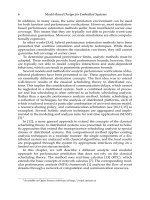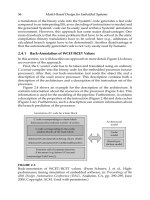CMP book embedded systems design - introduction
Bạn đang xem bản rút gọn của tài liệu. Xem và tải ngay bản đầy đủ của tài liệu tại đây (220.07 KB, 9 trang )
Introduction
The arrival of the microprocessor in the 1970s brought about a revolution of
control. For the first time, relatively complex systems could be constructed using a
simple device, the microprocessor, as its primary control and feedback element. If
you were to hunt out an old Teletype ASR33 computer terminal in a surplus store
and compare its innards to a modern color inkjet printer, there’s quite a difference.
Automobile emissions have decreased by 90 percent over the last 20 years,
primarily due to the use of microprocessors in the engine-management system.
The open-loop fuel control system, characterized by a carburetor, is now a fuel-
injected, closed-loop system using multiple sensors to optimize performance and
minimize emissions over a wide range of operating conditions. This type of
performance improvement would have been impossible without the microprocessor
as a control element.
Microprocessors have now taken over the automobile. A new luxury- class
automobile might have more than 70 dedicated microprocessors, controlling tasks
from the engine spark and transmission shift points to opening the window slightly
when the door is being closed to avoid a pressure burst in the driver’s ear.
The F-16 is an unstable aircraft that cannot be flown without on-board computers
constantly making control surface adjustments to keep it in the air. The pilot,
through the traditional controls, sends requests to the computer to change the
plane’s flight profile. The computer attempts to comply with those requests to the
extent that it can and still keep the plane in the air.
A modern jetliner can have more than 200 on-board, dedicated microprocessors.
The most exciting driver of microprocessor performance is the games market.
Although it can be argued that the game consoles from Nintendo, Sony, and Sega
are not really embedded systems, the technology boosts that they are driving are
absolutely amazing. Jim Turley[1], at the Microprocessor Forum, described a
200MHz reduced instruction set computer (RISC) processor that was going into a
next-generation game console. This processor could do a four-dimensional matrix
multiplication in one clock cycle at a cost of $25.
Why Embedded Systems Are Different
Well, all of this is impressive, so let’s delve into what makes embedded systems
design different — at least different enough that someone has to write a book
about it. A good place to start is to try to enumerate the differences between your
desktop PC and the typical embedded system.
Embedded systems are dedicated to specific tasks, whereas PCs are
generic computing platforms.
Embedded systems are supported by a wide array of processors and
processor architectures.
Embedded systems are usually cost sensitive.
Embedded systems have real-time constraints.
Note You’ll have ample opportunity to learn about real time. For now,
real- time events are external (to the embedded system) events that
must be dealt with when they occur (in real time).
If an embedded system is using an operating system at all, it is most
likely using a real-time operating system (RTOS), rather than Windows
9X, Windows NT, Windows 2000, Unix, Solaris, or HP- UX.
The implications of software failure is much more severe in embedded
systems than in desktop systems.
Embedded systems often have power constraints.
Embedded systems often must operate under extreme environmental
conditions.
Embedded systems have far fewer system resources than desktop
systems.
Embedded systems often store all their object code in ROM.
Embedded systems require specialized tools and methods to be
efficiently designed.
Embedded microprocessors often have dedicated debugging circuitry.
Embedded systems are dedicated to specific tasks, whereas PCs are
generic computing platforms
Another name for an embedded microprocessor is a dedicated microprocessor. It is
programmed to perform only one, or perhaps, a few, specific tasks. Changing the
task is usually associated with obsolescing the entire system and redesigning it.
The processor that runs a mobile heart monitor/defibrillator is not expected to run
a spreadsheet or word processor.
Conversely, a general-purpose processor, such as the Pentium on which I’m
working at this moment, must be able to support a wide array of applications with
widely varying processing requirements. Because your PC must be able to service
the most complex applications with the same performance as the lightest
application, the processing power on your desktop is truly awesome.
Thus, it wouldn’t make much sense, either economically or from an engineering
standpoint, to put an AMD-K6, or similar processor, inside the coffeemaker on your
kitchen counter.
Note That’s not to say that someone won’t do something similar. For
example, a French company designed a vacuum cleaner with an
AMD 29000 processor. The 29000 is a 32-bit RISC CPU that is far
more suited for driving laser-printer engines.
Embedded systems are supported by a wide array of processors and
processor architectures
Most students who take my Computer Architecture or Embedded Systems class
have never programmed on any platform except the X86 (Intel) or the Sun SPARC
family. The students who take the Embedded Systems class are rudely awakened
by their first homework assignment, which has them researching the available
trade literature and proposing the optimal processor for an assigned application.
These students are learning that today more than 140 different microprocessors
are available from more than 40 semiconductor vendors[2]. These vendors are in a
daily battle with each other to get the design-win (be the processor of choice) for
the next wide-body jet or the next Internet- based soda machine.
In Chapter 2
, you’ll learn more about the processor-selection process. For now,
just appreciate the range of available choices.
Embedded systems are usually cost sensitive
I say “usually” because the cost of the embedded processor in the Mars Rover was
probably not on the design team’s top 10 list of constraints. However, if you save
10 cents on the cost of the Engine Management Computer System, you’ll be a hero
at most automobile companies. Cost does matter in most embedded applications.
The cost that you must consider most of the time is system cost. The cost of the
processor is a factor, but, if you can eliminate a printed circuit board and
connectors and get by with a smaller power supply by using a highly integrated
microcontroller instead of a microprocessor and separate peripheral devices, you
have potentially a greater reduction in system costs, even if the integrated device
is significantly more costly than the discrete device. This issue is covered in more
detail in Chapter 3
.
Embedded systems have real-time constraints
I was thinking about how to introduce this section when my laptop decided to back
up my work. I started to type but was faced with the hourglass symbol because
the computer was busy doing other things. Suppose my computer wasn’t sitting on
my desk but was connected to a radar antenna in the nose of a commercial jetliner.
If the computer’s main function in life is to provide a collision alert warning, then
suspending that task could be disastrous.
Real-time constraints generally are grouped into two categories: time- sensitive
constraints and time-critical constraints. If a task is time critical, it must take place
within a set window of time, or the function controlled by that task fails.
Controlling the flight-worthiness of an aircraft is a good example of this. If the
feedback loop isn’t fast enough, the control algorithm becomes unstable, and the
aircraft won’t stay in the air.
A time-sensitive task can die gracefully. If the task should take, for example,
4.5ms but takes, on average, 6.3ms, then perhaps the inkjet printer will print two
pages per minute instead of the design goal of three pages per minute.
If an embedded system is using an operating system at all, it is most
likely using an RTOS
Like embedded processors, embedded operating systems also come in a wide
variety of flavors and colors. My students must also pick an embedded operating
system as part of their homework project. RTOSs are not democratic. They need
not give every task that is ready to execute the time it needs. RTOSs give the
highest priority task that needs to run all the time it needs. If other tasks fail to
get sufficient CPU time, it’s the programmer’s problem.
Another difference between most commercially available operating systems and
your desktop operating system is something you won’t get with an RTOS. You
won’t get the dreaded Blue Screen of Death that many Windows 9X users see on a
regular basis.
The implications of software failure are much more severe in embedded
systems than in desktop systems
Remember the Y2K hysteria? The people who were really under the gun were the
people responsible for the continued good health of our computer- based
infrastructure. A lot of money was spent searching out and replacing devices with
embedded processors because the #$%%$ thing got the dates all wrong.
We all know of the tragic consequences of a medical radiation machine that
miscalculates a dosage. How do we know when our code is bug free? How do you
completely test complex software that must function properly under all conditions?
However, the most important point to take away from this discussion is that
software failure is far less tolerable in an embedded system than in your average
desktop PC. That is not to imply that software never fails in an embedded system,
just that most embedded systems typically contain some mechanism, such as a
watchdog timer
, to bring it back to life if the software loses control. You’ll find out
more about software testing in Chapter 9
.
Embedded systems have power constraints
For many readers, the only CPU they have ever seen is the Pentium or AMD K6
inside their desktop PC. The CPU needs a massive heat sink and fan assembly to
keep the processor from baking itself to death. This is not a particularly serious
constraint for a desktop system. Most desktop PC’s have plenty of spare space
inside to allow for good airflow. However, consider an embedded system attached
to the collar of a wolf roaming around Wyoming or Montana. These systems must
work reliably and for a long time on a set of small batteries.
How do you keep your embedded system running on minute amounts of power?
Usually that task is left up to the hardware engineer. However, the division of
responsibility isn’t clearly delineated. The hardware designer might or might not
have some idea of the software architectural constraints. In general, the processor
choice is determined outside the range of hearing of the software designers. If the
overall system design is on a tight power budget, it is likely that the software
design must be built around a system in which the processor is in “sleep mode”
most of the time and only wakes up when a timer tick occurs. In other words, the
system is completely interrupt driven.
Power constraints impact every aspect of the system design decisions. Power
constraints affect the processor choice, its speed, and its memory architecture.
The constraints imposed by the system requirements will likely determine whether
the software must be written in assembly language, rather than C or C++,
because the absolute maximum performance must be achieved within the power
budget. Power requirements are dictated by the CPU clock speed and the number
of active electronic components (CPU, RAM, ROM, I/O devices, and so on).
Thus, from the perspective of the software designer, the power constraints could
become the dominant system constraint, dictating the choice of software tools,
memory size, and performance headroom.
TEAMFLY
Team-Fly
®
Speed vs. Power
Almost all modern CPUs are fabricated using the Complementary Metal Oxide
Silicon (CMOS) process. The simple gate structure of CMOS devices consists of two
MOS transistors, one N-type and one P-type (hence, the term complementary),
stacked like a totem pole with the N-type on top and the P-type on the bottom.
Both transistors behave like perfect switches. When the output is high, or logic
level 1, the P-type transistor is turned off, and the N-type transistor connects the
output to the supply voltage (5V, 3.3V, and so on), which the gate outputs to the
rest of the circuit.
When the logic level is 0, the situation is reversed, and the P-type transistor
connects the next stage to ground while the N-type transistor is turned off. This
circuit topology has an interesting property that makes it attractive from a power-
use viewpoint. If the circuit is static (not changing state), the power loss is
extremely small. In fact, it would be zero if not for a small amount of leakage
current inherent in these devices at normal room temperature and above.
When the circuit is switching, as in a CPU, things are different. While a gate
switches logic levels, there is a period of time when the N-type and P-type
transistors are simultaneously on. During this brief window, current can flow from
the supply voltage line to ground through both devices. Current flow means power
dissipation and that means heat. The greater the clock speed, the greater the
number of switching cycles taking place per second, and this means more power
loss. Now, consider your 500MHz Pentium or Athlon processor with 10 million or so
transistors, and you can see why these desktop machines are so power hungry. In
fact, it is almost a perfect linear relationship between CPU speed and power
dissipation in modern processors. Those of you who overclock your CPUs to wring
every last ounce of performance out of it know how important a good heat sink
and fan combination are.
Embedded systems must operate under extreme environmental conditions
Embedded systems are everywhere. Everywhere means everywhere. Embedded
systems must run in aircraft, in the polar ice, in outer space, in the trunk of a
black Camaro in Phoenix, Arizona, in August. Although making sure that the
system runs under these conditions is usually the domain of the hardware designer,
there are implications for both the hardware and software. Harsh environments
usually mean more than temperature and humidity. Devices that are qualified for
military use must meet a long list of environmental requirements and have the
documentation to prove it. If you’ve wondered why a simple processor, such as the
8086 from Intel, should cost several thousands of dollars in a missile, think
paperwork and environment. The fact that a device must be qualified for the
environment in which it will be operating, such as deep space, often dictates the
selection of devices that are available.
The environmental concerns often overlap other concerns, such as power
requirements. Sealing a processor under a silicone rubber conformal coating
because it must be environmentally sealed also means that the capability to
dissipate heat is severely reduced, so processor type and speed is also a factor.
Unfortunately, the environmental constraints are often left to the very end of the
project, when the product is in testing and the hardware designer discovers that
the product is exceeding its thermal budget. This often means slowing the clock,
which leads to less time for the software to do its job, which translates to further









